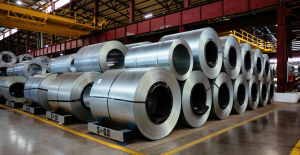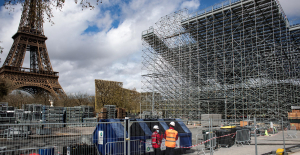WORLD: Mr. Schalk, you are a specialist lawyer for construction and architect law and deal primarily with civil engineering. What are typical cases here?
Günther Schalk: Building deep is initially the same as building upwards. Therefore, the legal problems are to a certain extent identical. However, one thing makes civil engineering completely different and also legally exciting, namely the subsoil: If you go just a spade depth under the turf and build down, it is a bit of clairvoyance what you will find down there.
WORLD: What can that be?
Schalk: For us, classic cases are cases in which a construction company suddenly encounters things that they had not expected – harder rock layers, groundwater, old building remains, any pipes or even an old aircraft bomb. Or the neighboring building suddenly slides into the excavation pit and no one knows why. Larger sums are then quickly involved because the work is stagnating and because it is often very time-consuming and technically expensive to get such surprises under control. And many a court finds it a bit difficult to understand this very special role of the subsoil.
WORLD: The soil in cities is becoming more and more filled. The spectrum ranges from cables and lines in increasing variety to countless underground car parks and large foundations to tunnels for transport projects. It was only this week that Telekom cables were damaged during S-Bahn work in Frankfurt am Main, which then led to a Lufthansa chaos. Is there a mess in the ground?
Schalk: You can't make such a blanket statement. And in this specific case, I don't want to and can't say what the exact cause was and who is "to blame" for the accident. To do this, you have to know all aspects of such a case, no matter how small. But one thing is clear: the more cables, lines and other - as the technician says - sections are buried in the ground, the higher the risk that exactly such a cable will be damaged on a subsequent construction site.
Of course, there is sometimes a bit of sloppiness when it comes to such sectors. Or it just pushes, then somehow it falls by the wayside. The position of cables and lines is not always correctly documented because the line may not always have been laid exactly where it was intended. There is also no place where such information could be accessed centrally.
Years later, the next client puts civil engineering works out to tender without inquiring too precisely where anything is already in the ground. The construction companies that carry out the work rely on it and often do not ask the potential service providers precisely enough before the construction work, where exactly the lines are located - although the case law requires this of the construction companies. And it's already happened.
WORLD: In Berlin, an old tunnel of the U2 subway was recently damaged by a high-rise building on Alexanderplatz, leading to months of closures. How can this happen?
Schalk: Well, Berlin has of course made a name for itself with the new airport, so to speak, for breakdowns and disasters during construction. But that is sometimes also a piece of polemics. As far as the U2 is concerned: You would have to know all the details here too. But there is a real problem behind this. Anyone who builds a high-rise building like this must first have a very precise investigation carried out to determine what is in the possible sphere of influence, how it is structurally constructed and what measures are necessary to protect this building. To do this, he needs specialized planners who can give him competent but also unsparing advice on the issues.
WORLD: A particular problem in Berlin?
Schalk: There are incidents like this elsewhere too. The causes are always individual constellations. A sad and prominent example was the collapse of the city archives in Cologne when a subway line was being built under the building. And there are countless cases that are not so well-known. Whether such a disruption was foreseeable or not is a classic in the often year-long court proceedings that follow such disruptions. You can often really argue technically and, above all, legally.
WORLD: The tunnel plans for transport projects are getting bolder. According to the plan for a second main S-Bahn line in Munich, existing tunnels are to be tunneled over, and such tunnels would also have to be constructed for the further construction of the A 100 motorway in Berlin. Are the traffic planners taking over?
Schalk: If the "normal" depth at which, for example, an underground S-Bahn line is usually built, is already occupied, the planners just have to be more creative. Sometimes a subway line is then “underground”, so to speak, with another, new subway line. Not only the actual tunnels, but also the associated structures such as train stations or the corresponding entrances to them are becoming correspondingly more technically demanding.
The traffic planners can manage that - look at Norway. The Boknafjord Tunnel will be 27 kilometers long and will be almost 400 meters below sea level. From a planning and technical point of view, almost everything is underground today. In this respect, I have no doubt that the second main S-Bahn line in Munich will be finished at some point. The crucial question will only be: when and at what price?
WORLD: How high are the prices?
Schalk: If you build a single meter of federal highway above ground, it will cost you between 2,000 and 10,000 euros. If you build the same road in a tunnel, you will pay around 60,000 euros for it - per meter! Theoretically, many cities could build new bypasses somewhere underground, then there would be no more problems with nature reserves and no more traffic noise in the area. But most municipalities cannot afford it. Especially given the currently tense budgetary situation.
WORLD: What is the main thing to look out for in such planning?
Schalk: First of all, that savings are not made at the wrong end. When it comes to legal disputes, I find time and again that the ground on which to build was only half-heartedly examined, that there was no or only insufficient ordnance research and sometimes planners were at work who were overwhelmed by the dimensions of a structure. Special civil engineering and tunnel construction are very demanding, complex and prone to failure. So it's worth doing one too many preliminary examinations rather than one too few.
The same applies to the water conditions. And then of course there are always neighbors, not just the classic ones on the property next to civil engineering, but also those who “live” below, like with a subway. It is also important that anyone who builds an underground car park or a tunnel must be aware that unforeseeable problems in the subsoil can cause construction costs to suddenly increase massively.
WORLD: Why does everyone always want to go into the ground?
Schalk: In my opinion, the reasons are very different. An important reason, especially with many public projects, is that it is simply "chic" and the quality of life of the residents is significantly increased when a street is underground and not above ground.
Check out the Petuel Tunnel in Munich. The city simply laid a section of the very busy Mittlerer Ring underground and laid out a huge park where the road used to be. Today it has become a really beautiful green oasis, where previously residents could not open their windows because of the noise and exhaust fumes.
Another aspect that is becoming increasingly important: If you build something underground, less surface is sealed at the top. And sometimes the reason is simply that there is not enough space above ground, for example because the building plot is limited and you can only accommodate what you want to build if you build vertically.
WORLD: Could it be that cities sometimes have to pull the rip cord and say that the ground is too full?
Schalk: I think we're still a long way from that. There is still a comparatively large amount of space in the ground, even in the cities. And if there is no more space, you can usually always go down one floor, especially with traffic routes. Whether one still builds in this way is at some point primarily a question of cost. The deeper, the more expensive. And if, for example, you want to lay a road 30 meters underground, you will of course also need much longer ramp structures so that you can finally accommodate the traffic at this depth.
WORLD: What does that mean specifically?
Schalk: As is well known, the German regulatory landscape is quite extensive, and in this respect there are of course also corresponding specifications as to what maximum gradient, for example, ramp structures for road traffic or the railways may have. I rather see the problem here that the city planners will at some point no longer accommodate these access structures in view of the cities being totally overcrowded on the surface. In this respect, I think that the overall system of "underground construction" in traffic routes in large cities can actually reach its limits at some point.
WORLD: What would it mean for the traffic planning of the cities if tunnel solutions are not possible for reasons of space and money?
Schalk: Nothing good. A certain hopelessness. The positive aspects that we talked about earlier would then simply have to be absent. At the same time, however, this also means that when it comes to transport, especially in the big cities, the capacities cannot be expanded at will in the future. Not in general, but certainly in certain cities and there in certain areas, at some point you will have to realize that more space for traffic is no longer possible, even if you dodge underground.
WORLD: And then?
Schalk: Then only one choice remains: either reduce traffic, which many would like ideologically but is unrealistic, or live with congested, overcrowded cities. But as already said: In my opinion, the limits and barriers in practice will first be shown by the cost aspect and only two steps later the question of what is technically feasible.
"Kick-off Politics" is WELT's daily news podcast. The most important topic, analyzed by WELT editors, and the dates of the day. Subscribe to the podcast on Spotify, Apple Podcasts, Amazon Music, among others, or directly via RSS feed.

 Sudan ravaged by a year of war
Sudan ravaged by a year of war Ten years after the kidnapping of the Chibok girls, what has become of the terrorist group Boko Haram?
Ten years after the kidnapping of the Chibok girls, what has become of the terrorist group Boko Haram? The Israeli government divided on the extent of its response after Iran's direct attack on its territory
The Israeli government divided on the extent of its response after Iran's direct attack on its territory “Is it time for a killing blow?” : the Israeli press wonders about a response after the Iranian attack
“Is it time for a killing blow?” : the Israeli press wonders about a response after the Iranian attack Covid-19: everything you need to know about the new vaccination campaign which is starting
Covid-19: everything you need to know about the new vaccination campaign which is starting The best laptops of the moment boast artificial intelligence
The best laptops of the moment boast artificial intelligence Amazon invests 700 million in robotizing its warehouses in Europe
Amazon invests 700 million in robotizing its warehouses in Europe Inflation rises to 3.2% in March due to gasoline and electricity bills
Inflation rises to 3.2% in March due to gasoline and electricity bills Large French companies are alarmed by the stalling of the European economy
Large French companies are alarmed by the stalling of the European economy New sanctions against Russia send industrial metal prices soaring
New sanctions against Russia send industrial metal prices soaring Olympic Games 2024: civil servants authorized to carry out private security activities
Olympic Games 2024: civil servants authorized to carry out private security activities Threat of strikes for the 2024 Olympics: Macron says he has “confidence” in the “spirit of responsibility” of the unions
Threat of strikes for the 2024 Olympics: Macron says he has “confidence” in the “spirit of responsibility” of the unions Musical show: “Come Bach”, fantasies around the composer
Musical show: “Come Bach”, fantasies around the composer The cry of alarm from Senghor's friends has been heard
The cry of alarm from Senghor's friends has been heard World Chess Championship: Nepomniachtchi and Gukesh lead the candidates tournament
World Chess Championship: Nepomniachtchi and Gukesh lead the candidates tournament Rapper Heuss L’Enfoiré calls on Ronaldinho for his new music video
Rapper Heuss L’Enfoiré calls on Ronaldinho for his new music video Skoda Kodiaq 2024: a 'beast' plug-in hybrid SUV
Skoda Kodiaq 2024: a 'beast' plug-in hybrid SUV Tesla launches a new Model Y with 600 km of autonomy at a "more accessible price"
Tesla launches a new Model Y with 600 km of autonomy at a "more accessible price" The 10 best-selling cars in March 2024 in Spain: sales fall due to Easter
The 10 best-selling cars in March 2024 in Spain: sales fall due to Easter A private jet company buys more than 100 flying cars
A private jet company buys more than 100 flying cars This is how housing prices have changed in Spain in the last decade
This is how housing prices have changed in Spain in the last decade The home mortgage firm drops 10% in January and interest soars to 3.46%
The home mortgage firm drops 10% in January and interest soars to 3.46% The jewel of the Rocío de Nagüeles urbanization: a dream villa in Marbella
The jewel of the Rocío de Nagüeles urbanization: a dream villa in Marbella Rental prices grow by 7.3% in February: where does it go up and where does it go down?
Rental prices grow by 7.3% in February: where does it go up and where does it go down? Europeans: the schedule of debates to follow between now and June 9
Europeans: the schedule of debates to follow between now and June 9 Europeans: “In France, there is a left and there is a right,” assures Bellamy
Europeans: “In France, there is a left and there is a right,” assures Bellamy During the night of the economy, the right points out the budgetary flaws of the macronie
During the night of the economy, the right points out the budgetary flaws of the macronie Europeans: Glucksmann denounces “Emmanuel Macron’s failure” in the face of Bardella’s success
Europeans: Glucksmann denounces “Emmanuel Macron’s failure” in the face of Bardella’s success These French cities that will boycott the World Cup in Qatar
These French cities that will boycott the World Cup in Qatar Augusta Masters: the unchallenged reign of Scottie Scheffler
Augusta Masters: the unchallenged reign of Scottie Scheffler Tennis: Harold Mayot takes Cachin and goes to the second round in Barcelona
Tennis: Harold Mayot takes Cachin and goes to the second round in Barcelona Barça-PSG: “We will do it”, Luis Enrique shows his confidence before the return match
Barça-PSG: “We will do it”, Luis Enrique shows his confidence before the return match Hakimi on Mbappé before Barça-PSG: “I feel very good, very motivated, like the whole team”
Hakimi on Mbappé before Barça-PSG: “I feel very good, very motivated, like the whole team”


















